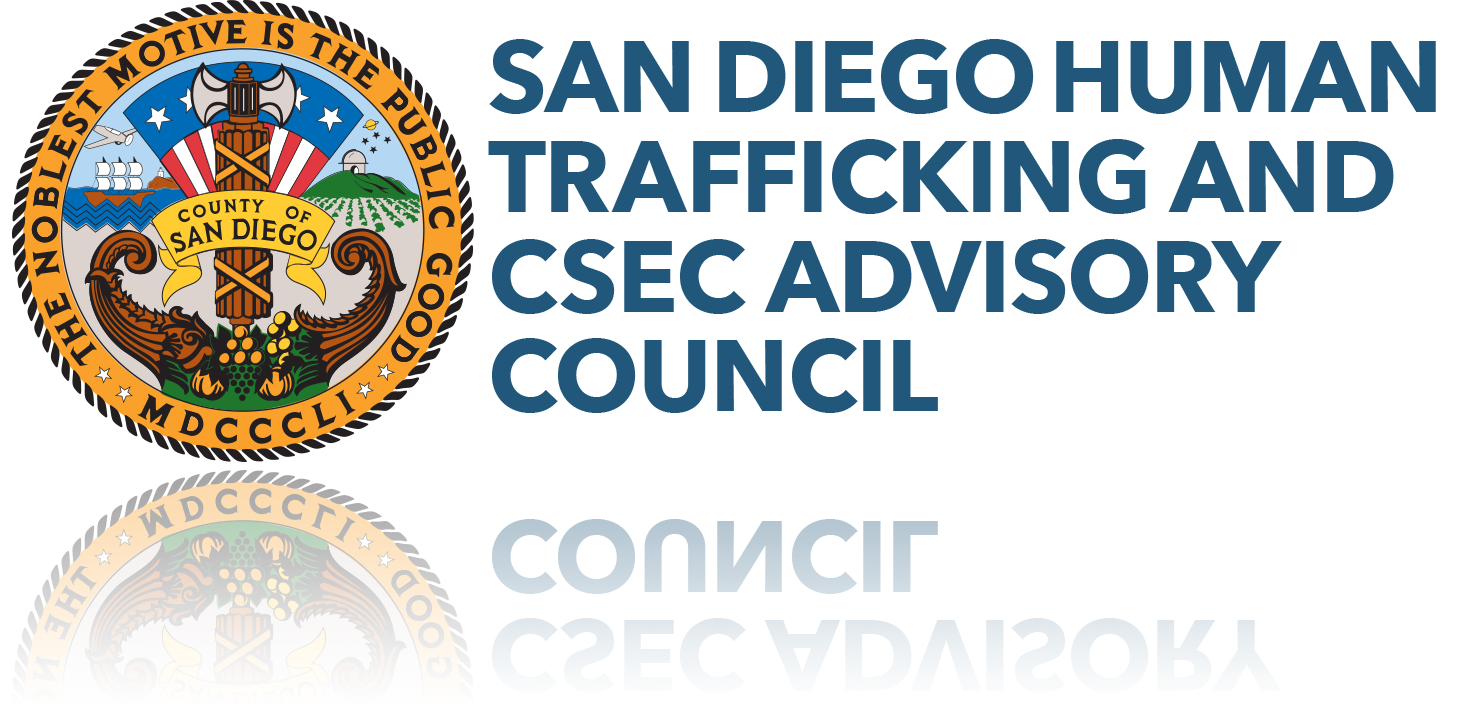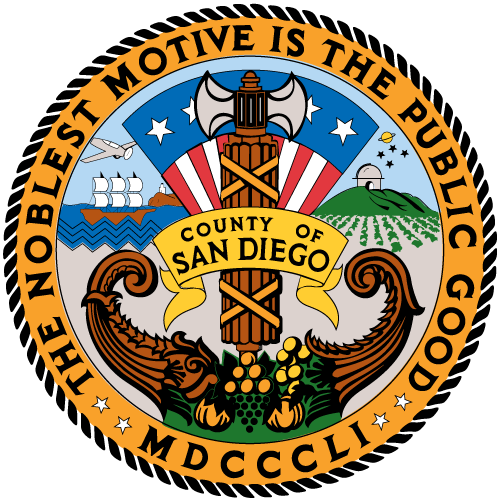Frequently Asked Answered Question
This Frequently Asked Question (FAQ) page is to help you answer various questions about Human Trafficking.
We look forward to expanding this page as more questions arise. If you have a question, please contact us and we will be happy to answer. Who knows? Maybe your question will end up on this page!
San Diego County understands the importance to clearly answer the question of
“What is Human Trafficking?”
Human Trafficking is a person taking control of another person’s freedom by using or exploiting that person for money or profit. This is also called Modern Slavery.
The person in control of the other person is called the Trafficker.
The person being used or exploited is the Victim of this crime.
Victims can be children, women or men of any age, race or nationality.
There are many types and examples of Human Trafficking.
In the United States any child under the age of 18 who has been involved in commercial sex acts is considered a trafficking victim.
San Diego County is committed to End Human Trafficking. We ask you to Join the Fight!
Warning Signs
Since human trafficking is often a crime that is hidden in plain sight, it is important to be aware of its warning signs. Some indications that a person may be a victim of human trafficking include (especially in the case of women and children):
- Appearing malnourished
- Showing signs of physical injuries and abuse
- Avoiding eye contact, social interaction, and authority figures/law enforcement
- Seeming to adhere to scripted or rehearsed responses in social interaction
- Lacking official identification documents
- Appearing destitute/lacking personal possessions
- Working excessively long hours
- Living at place of employment
- Checking into hotels/motels with older males, and referring to those males as boyfriend or “daddy,” which is often street slang for pimp
- Poor physical or dental health
- Tattoos/ branding on the neck and/or lower back
- Untreated sexually transmitted diseases
- Small children serving in a family restaurant
- Security measures that appear to keep people inside an establishment – barbed wire inside of a fence, bars covering the insides of windows
- Not allowing people to go into public alone, or speak for themselves
These warning signs are adapted from information provided by the Polaris Project and its National Human Trafficking Resource Center and Innocents at Risk.
Answering the question of “What are Examples of Human Trafficking?”
We need to understand how this can happen to someone. Adults and children can be prepare or trained; this is also called grooming; or persuaded; also known as coercion; to do an activity by using force or threats by someone controlling another person for money or profit. There are situations of a trade where the trafficker or controller is trapping the other person by providing a place to live, food, and /or clothing; no matter how poor the living conditions or bad the food is; in exchange for the other person, the victim, to do these activities instead of paying rent or for the food or clothing. There is not a dollar amount of money attached to the things being provided and resulting in a no end in sight situation.
There are many examples of Human Trafficking. The trafficker or controller uses the ways described above to lure the other person, which becomes the victim into doing the following examples:
Sex for Sale:
- Prostitution
- Pornography
- Sex Videos and/or Pictures
- Massages
- Strip Club Dancing
- Mail Order Brides
- Forced Marriage
- Child Marriage
- Wife/Husband Selling
- Sex Slavery
Entrapment through working as a Laborer:
- Farm or Agricultural Work
- Construction
- Manufacturing
- House Keeping
- Hotel Services such as a Maid
- Health or Elder Care Giver
- Hair or Nail Salon Worker
- Child Labor
Unfortunately, we are learning more cleaver ways the traffickers are using to controll and use other people; including forcing children to be soliders.
Please contact us if you or someone you know is in a situation like what is described above.
What are the types of human trafficking?
- Trafficking for forced labour.
- Trafficking for forced criminal activities.
- Trafficking in women for sexual exploitation.
- Trafficking for the removal of organs.
- People smuggling.
Content coming soon!
Modern prohibitions of human trafficking in the United States have their roots in the 13th Amendment to the U.S. Constitution, which barred slavery and involuntary servitude in 1865. Prior to 2000, the Department of Justice (DOJ) filed human trafficking cases under several federal statutes related to involuntary servitude and slavery, but the criminal laws were narrow and patchwork.
The Trafficking Victims Protection Act of 2000 (TVPA), Pub. L. No. 106- 386, in 2000, equipped the U.S. Government with new tools and resources to mount a comprehensive and coordinated campaign to eliminate modern forms of slavery domestically and internationally.
Critically, the TVPA established the framework for the “3 P’s” of the fight against human trafficking: protection, prevention, and prosecution.
Protection
The TVPA provided increased protections for trafficking victims in the United States in several key ways:
- By making foreign victims eligible for federally funded or administered health and other benefits and services and by requiring federal agencies to expand the provision of such benefits and services to victims, regardless of their immigration status;
- By creating immigration protections for foreign national victims of human trafficking, including protection from removal for victims of trafficking (the T visa) and victims of certain crimes (the U visa); and
- By allowing certain nonimmigrant status holders the opportunity to adjust to permanent resident status.
Prevention
The TVPA strengthened the U.S. Government’s prevention efforts by
- Providing for international initiatives to be established and carried out to improve economic opportunity for potential victims as a means of deterring trafficking.
- Creating the Office to Monitor and Combat Trafficking in Persons in the State Department, making that office responsible for publishing an annual Trafficking In Persons (TIP) report that describes and ranks the efforts of countries to combat human trafficking. The TIP Report is the U.S. Government’s principal diplomatic tool to engage foreign governments on human trafficking.
- Requiring the President to establish an Interagency Task Force to Monitor and Combat Trafficking (PITF), a coordinating task force comprising cabinet-level officers chaired by the Secretary of State, and directed it to carry out activities that included measuring and evaluating the progress of the United States and other countries in preventing human trafficking, protecting its victims, and prosecuting its perpetrators.
Prosecution
The TVPA sharpened and enhanced the capacity of federal prosecutors to bring human traffickers to justice for their crimes by:
- Adding new criminal provisions prohibiting forced labor, trafficking with respect to peonage, slavery, involuntary servitude, or forced labor, and sex trafficking of children or by force, fraud, or coercion;
- Criminalizing attempts to engage in these activities; Mandating that traffickers pay restitution to their victims, and providing for forfeiture;
- Strengthening penalties for existing trafficking crimes
(source: US Department of Justice website https://www.justice.gov/humantrafficking/key-legislation#:~:text=The%20Trafficking%20Victims%20Protection%20Act%20of%202000%20(TVPA)%2C%20Pub,of%20slavery%20domestically%20and%20internationally.)
5 Minutes, 5 hours, 5 days, or more
There are so many ways that you can help depending on the amount of time you have to invest.
If you have 5 minutes:
~Call your representatives & ask them to support bills that fund survivor programs or otherwise assist in the fight against trafficking.
~Write a check or make a contribution on line to one of the existing programs in San Diego.
~ Spread the word, talk with a friend about what is happening in San Diego (or nationwide) with sex or labor trafficking.
If you have 5 hours:
~ Read a book on trafficking, or go online, educate yourself more on what is happening in the U.S. with human trafficking.
~Volunteer with one of the existing programs in San Diego, mentoring survivors, doing repairs, landscaping, clean-up projects, teach a class to survivors, give survivors a ride to doctors’s appointments, join a walk against trafficking, move furniture to or from a safe house…
If you have 5 days:
Volunteer to teach a class once a week for 5 weeks to survivors about whatever your gift or talent might be, help set up or take down for a program gala or other event,
If you have more time on a regular basis:
Investigate the needs of the anti-human trafficking programs around town:
~ Hope for San Diego (supports anti-trafficking housing & programs in San Diego)
~Alabaster Jar (housing & program for sex trafficking survivors)
~ GenerateHope (housing & program for sex trafficking survivors)
~ BSCC (housing for sex & labor trafficking survivors)
~ North County Lifeline (housing & programs for sex trafficking survivors)
San Diego Human Trafficking and CSEC Advisory Council
Contact us at: email@htadvisorycouncil.or

